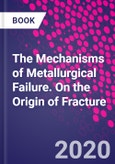Metallurgy of Fracture: The Mechanics of Metal Failure looks at the origin of metal defects, their related mechanisms of failure, and the modification of casting procedures to eliminate these defects, clearly connecting the strength and durability of metals with their fabrication process. The book starts with a focus on the fracture of liquids, looking at topics such as homogeneous and heterogeneous nucleation, entrainment processes in bifilms and bubbles, furling and unfurling, ingot casting, continuous casting, and more. From there it discusses fracture of liquid and solid state, focusing on topics such as externally and internally initiated tearing. The book then concludes with a section discussing fracture of solid metals covering concepts such as ductility and brittleness, dislocation mechanisms, the relationship between the microstructure and properties of metals, corrosion, hydrogen embrittlement, and more. Improved approaches to fabrication and casting processes that will help eliminate these defects are provided throughout.
Please Note: This is an On Demand product, delivery may take up to 11 working days after payment has been received.
Table of Contents
1. Theoretical Strength of Liquids2. Non-Classical Mechanisms of Fracture in Metals3. Experimental Hydrostatic Tensions in Liquids4. Entrainment Processes5. Entrainment Avoidance6. The Quest for Clean Steels7. Externally Initiated Tearing8. Internally Initiated Tearing9. The Concepts of Ductility and Brittleness10. Theoretical Strength of the Solid11. Theoretical Strength Summary12. Consolidation13. Microstructure and Properties of Metals








